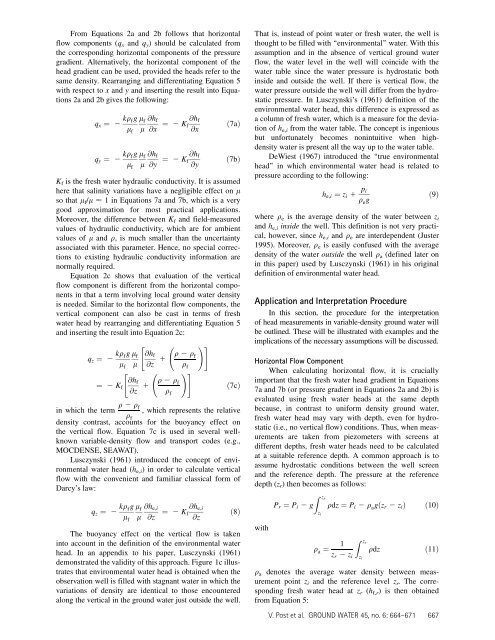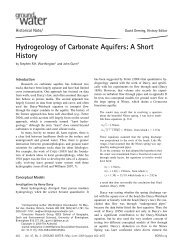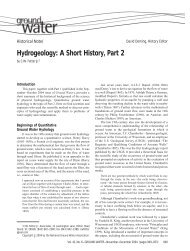Using Hydraulic Head Measurements in Variable ... - Info Ngwa
Using Hydraulic Head Measurements in Variable ... - Info Ngwa
Using Hydraulic Head Measurements in Variable ... - Info Ngwa
You also want an ePaper? Increase the reach of your titles
YUMPU automatically turns print PDFs into web optimized ePapers that Google loves.
F rom E quations 2a and 2b follows that horizontal<br />
flow components (qx and qy) should be calculated from<br />
the correspond<strong>in</strong>g horizontal components of the pressure<br />
gradient. Alternatively, the horizontal component of the<br />
head gradient can be used, provided the heads refer to the<br />
same density. R earrang<strong>in</strong>g and differentiat<strong>in</strong>g E quation 5<br />
with respect to x and y and <strong>in</strong>sert<strong>in</strong>g the result <strong>in</strong>to E quations<br />
2a and 2b gives the follow<strong>in</strong>g:<br />
qx ¼ 2 kqfg lf @hf<br />
lf l @x<br />
qy ¼ 2 kqfg lf @hf<br />
lf l @y<br />
@hf<br />
¼ 2 Kf<br />
@x<br />
@hf<br />
¼ 2 Kf<br />
@y<br />
ð7 aÞ<br />
ð7 bÞ<br />
Kf is the fresh water hydraulic conductivity. It is assumed<br />
here that sal<strong>in</strong>ity variations have a negligible effect on l<br />
so that lf/l ’ 1 <strong>in</strong> E quations 7 a and 7 b, which is a very<br />
good approximation for most practical applications.<br />
M oreover, the difference between Kf and field-measured<br />
values of hydraulic conductivity, which are for ambient<br />
values of l and q, is much smaller than the uncerta<strong>in</strong>ty<br />
associated with this parameter. H ence, no special corrections<br />
to exist<strong>in</strong>g hydraulic conductivity <strong>in</strong>formation are<br />
normally required.<br />
E quation 2c shows that evaluation of the vertical<br />
flow component is different from the horizontal components<br />
<strong>in</strong> that a term <strong>in</strong>volv<strong>in</strong>g local ground water density<br />
is needed. S imilar to the horizontal flow components, the<br />
vertical component can also be cast <strong>in</strong> terms of fresh<br />
water head by rearrang<strong>in</strong>g and differentiat<strong>in</strong>g E quation 5<br />
and <strong>in</strong>sert<strong>in</strong>g the result <strong>in</strong>to E quation 2c:<br />
qz ¼ 2 kq fg<br />
l f<br />
¼ 2 Kf<br />
l f<br />
l<br />
"<br />
@hf<br />
@z 1<br />
"<br />
@hf<br />
@z 1<br />
q 2 q f<br />
q f<br />
q 2 q f<br />
q f<br />
! #<br />
! #<br />
ð7 cÞ<br />
<strong>in</strong> which the term q 2 qf , which represents the relative<br />
q f<br />
density contrast, accounts for the buoyancy effect on<br />
the vertical flow. E quation 7 c is used <strong>in</strong> several wellknown<br />
variable-density flow and transport codes (e.g.,<br />
M O C DE NS E , S E AWAT) .<br />
L usczynski (1961) <strong>in</strong>troduced the concept of environmental<br />
water head (he,i) <strong>in</strong> order to calculate vertical<br />
flow with the convenient and familiar classical form of<br />
Darcy’s law:<br />
qz ¼ 2 kqfg lf @he;i<br />
lf l @z<br />
@he;i<br />
¼ 2 Kf<br />
@z<br />
ð8Þ<br />
The buoyancy effect on the vertical flow is taken<br />
<strong>in</strong>to account <strong>in</strong> the def<strong>in</strong>ition of the environmental water<br />
head. In an appendix to his paper, L usczynski (1961)<br />
demonstrated the validity of this approach. F igure 1c illustrates<br />
that environmental water head is obta<strong>in</strong>ed when the<br />
observation well is filled with stagnant water <strong>in</strong> which the<br />
variations of density are identical to those encountered<br />
along the vertical <strong>in</strong> the ground water just outside the well.<br />
That is, <strong>in</strong>stead of po<strong>in</strong>t water or fresh water, the well is<br />
thought to be filled with ‘ ‘ environmental’’ water. With this<br />
assumption and <strong>in</strong> the absence of vertical ground water<br />
flow, the water level <strong>in</strong> the well will co<strong>in</strong>cide with the<br />
water table s<strong>in</strong>ce the water pressure is hydrostatic both<br />
<strong>in</strong>side and outside the well. If there is vertical flow, the<br />
water pressure outside the well will differ from the hydrostatic<br />
pressure. In L usczynski’s (1961) def<strong>in</strong>ition of the<br />
environmental water head, this difference is expressed as<br />
a column of fresh water, which is a measure for the deviation<br />
of he,i from the water table. The concept is <strong>in</strong>genious<br />
but unfortunately becomes non<strong>in</strong>tuitive when highdensity<br />
water is present all the way up to the water table.<br />
DeWiest (1967 ) <strong>in</strong>troduced the ‘ ‘ true environmental<br />
head’’ <strong>in</strong> which environmental water head is related to<br />
pressure accord<strong>in</strong>g to the follow<strong>in</strong>g:<br />
he;i ¼ zi 1 pi<br />
q eg<br />
ð9Þ<br />
where qe is the average density of the water between zi<br />
and he,i <strong>in</strong> s id e the well. This def<strong>in</strong>ition is not very practical,<br />
however, s<strong>in</strong>ce he,i and qe are <strong>in</strong>terdependent (J uster<br />
1995) . M oreover, qe is easily confused with the average<br />
density of the water o u t s id e the well qa (def<strong>in</strong>ed later on<br />
<strong>in</strong> this paper) used by L usczynski (1961) <strong>in</strong> his orig<strong>in</strong>al<br />
def<strong>in</strong>ition of environmental water head.<br />
Ap p lication and Interp retation P rocedure<br />
In this section, the procedure for the <strong>in</strong>terpretation<br />
of head measurements <strong>in</strong> variable-density ground water will<br />
be outl<strong>in</strong>ed. These will be illustrated with examples and the<br />
implications of the necessary assumptions will be discussed.<br />
Horiz ontal Flow C omp onent<br />
When calculat<strong>in</strong>g horizontal flow, it is crucially<br />
important that the fresh water head gradient <strong>in</strong> E quations<br />
7 a and 7 b (or pressure gradient <strong>in</strong> E quations 2a and 2b) is<br />
evaluated us<strong>in</strong>g fresh water heads at the same depth<br />
because, <strong>in</strong> contrast to uniform density ground water,<br />
fresh water head may vary with depth, even for hydrostatic<br />
(i.e., no vertical flow) conditions. Thus, when measurements<br />
are taken from piezometers with screens at<br />
different depths, fresh water heads need to be calculated<br />
at a suitable reference depth. A common approach is to<br />
assume hydrostatic conditions between the well screen<br />
and the reference depth. The pressure at the reference<br />
depth (zr) then becomes as follows:<br />
with<br />
Pr ¼ Pi 2 g<br />
Z zr<br />
zi<br />
qdz ¼ Pi 2 q agðzr 2 ziÞ ð10 Þ<br />
qa ¼ 1<br />
Z zr<br />
qdz ð11Þ<br />
zr 2 zi zi<br />
q a denotes the average water density between measurement<br />
po<strong>in</strong>t zi and the reference level zr. The correspond<strong>in</strong>g<br />
fresh water head at zr (hf,r) is then obta<strong>in</strong>ed<br />
from E quation 5:<br />
V. P ost et al. GROUND WATER 45, n o. 6: 664–671 667




